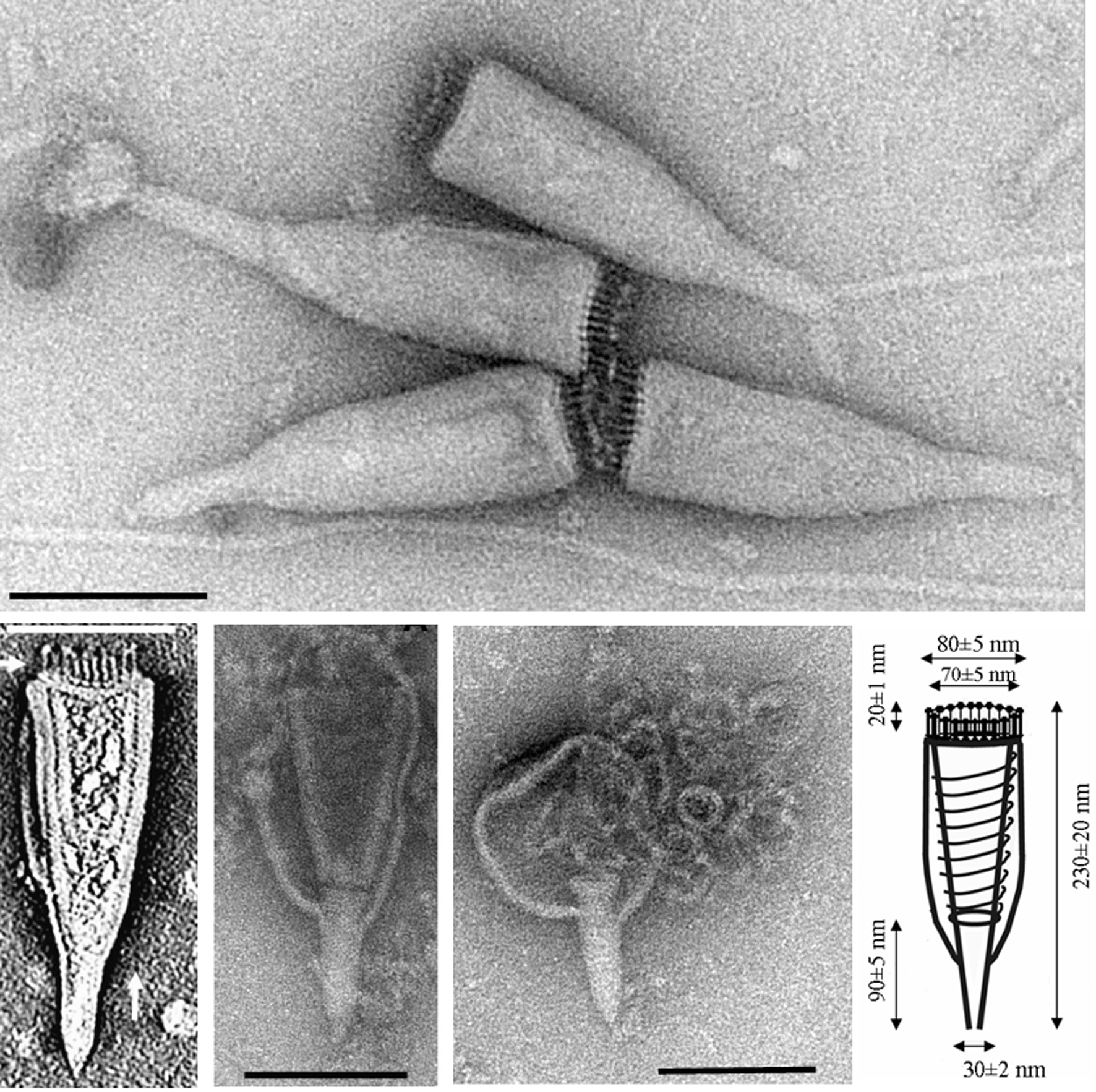Family: Ampullaviridae
Chapter Version: ICTV Ninth Report; 2009 Taxonomy Release
Since only one genus is currently recognized, the family description corresponds to the genus description.
Genus Ampullavirus
Type species Acidianus bottle-shaped virus
Virion properties
Morphology
The virion is enveloped, resembles in its shape a bottle and has an overall length of about 230 nm and a width varying from about 75 nm, at the broad end, to 4 nm, at the pointed end (Figure 1). The broad end of the virion exhibits 20 (±2) thin rigid filaments, 20 nm long and 3 nm in width, which appear to be interconnected at their bases and regularly distributed around, and inserted into, a disc or ring. The 9-nm-thick envelope encases a funnel-shaped core formed by a torroidally supercoiled nucleoprotein filament, 7 nm in width. The core structure shows striations running perpendicularly to the long axis, with periodicities of 13 nm−1 and 4.3 nm−1, indicative of helical arrangement of subunits.
Physicochemical and physical properties
Virion buoyant density in sucrose is about 1.3 g cm−3. The virions are fragile and disrupted by high speed ultracentrifugation, as well as by prolonged storage in buffers. The pointed end of the virion, rather than the broad end, is likely to be involved in adsorption.
Nucleic acid
Virions contain one molecule of dsDNA of 23,814 bp, with a GC content of 35%.
Proteins
The virions carry six major proteins in the size range 15 to 80 kDa.
Lipids
None reported.
Carbohydrates
None reported.
Genome organization and replication
The linear genome carries 590-bp-long inverted terminal repeats. It encodes 57 predicted proteins and contains two large non-coding regions, of about 600 and 300 bp (Figure 2). Fifteen pairs of genes show small overlaps. Three genes contain putative internal start codons with ribosome-binding sites. The DNA polymerase, putative glycosyltransferase and thymidylate kinase are encoded on the viral genome. Several predicted proteins show recognisable structural motifs. The RNA has predicted secondary structure highly similar to that of the prohead RNA of bacteriophage 29 and may be involved in genome packaging. Viral DNA polymerase is apparently responsible for genome replication. Its properties, predicted from sequence analysis, imply a protein-primed replication model.
Antigenic properties
No information available.
Biological properties
The virus was isolated from a hot acidic spring (87–93 °C, pH 1.5–2.0) in Pozzuoli, Italy. The host range is limited to autochthonous species of hyperthermophilic archaea from the genus Acidianus. Host lysis is not observed. Virus infection increases a generation time of the host from about 24 hours to about 48 hours. Release of particles is observed only in the stationary growth phase of the host culture.
Species demarcation criteria in the genus
Not applicable.
List of species in the genus Ampullavirus
| Acidianus bottle-shaped virus |
|
|
| Acidianus bottle-shaped virus | [EF432053] | (ABV) |
Species names are in italic script; names of strains are in roman script. Sequence accession numbers [ ] and assigned abbreviations ( ) are also listed.
List of other related viruses which may be members of the genus Ampullavirus but have not been approved as species
None reported.
List of unassigned species in the family Ampullaviridae
None reported.
Phylogenetic relationships within the family
Not applicable.
Similarity with other taxa
Not known.
Derivation of name
Ampulla: From Latin ampulla, for “bottle”.
Further reading
Häring, M., Rachel, R., Peng, X., Garrett, R.A. and Prangishvili, D. (2005). Diverse viruses in hot springs of Pozzuoli, Italy, and characterization of a unique archaeal virus, Acidianus bottle shaped virus, from a new family, the Ampullaviridae. J. Virol., 79, 9904-9911.
Peng, X., Basta, T., Häring, M., Garrett, R.A. and Prangishvili, D. (2007). Genome of the Acidianus bottle-shaped virus and insights into the replication and packaging mechanisms. Virology, 364, 237-243.
Prangishvili, D., Forterre, P. and Garrett, R.A. (2006). Viruses of the Archaea: a unifying view. Nat. Rev. Microbiol., 4, 837-848.
Prangishvili, D., Garrett, R.A. and Koonin, E.V. (2006). Evolutionary genomics of archaeal viruses: Unique viral genomes in the third domain of life. Virus Res., 117, 52-67.
Contributed by
Prangishvili, D.
Figures
Figures
Figure 1 Negative contrast electron micrographs of virions of an isolate of Acidianus bottle-shaped virus. (Top) Intact virions. (Bottom, left) Horizontal slice (0.7 nm) though the three dimensional data set of the 3D reconstruction of the virion. (Bottom, center) partially disrupted virions. (Bottom, right) Schematic representation of the virion. The scale bars represent 100 nm.
(Modified from Hring et al. (2005). J. Virol., 79, 99049911.)

Figure 2 Genome organisation of Acidianus bottle-shaped virus, showing location, sizes and direction of putative genes. The square indicates the position of the RNA gene. Red arrows indicate genes with assigned functions or recognizable structural motifs, while putative genes of unknown structure and function are denoted by yellow arrows. Three internal ORFs are denoted by green arrows and their amino acid sizes are given in brackets.
(Modified from Peng et al. (2007). Virology364, 237243.)

